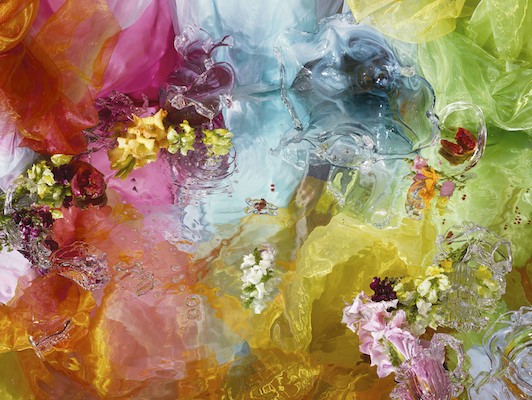February 26: Aerial
26-2-2017, On This Date in Photography, James MM Cardle
Margriet Smulders (Bussum, The Netherlands, 1955) is inspired by Dutch still lifes of the seventeenth century; flowers in bloom, full to the verge of dropping all their petals. Earlier work reveals a visible backdrop of mirrors for this cornucopia and the inclusion of hand-cast, moulded and slumped glass works (which I assume are not made by Smulders herself) with glass beads amongst the blooms and leaves.
The work is certainly sensual and builds on the gastronomic, sexual, olfactory, and tactile symbolism of flora and botanica, while the inclusion of a knife and the mirror hint at still other appetites, including narcissism. Brightly and broadly lit, their passionate moods are represented in hue rather than tone. Mijn Droom of 2001 makes that explicit.

Margriet Smulders (2001) Mijn Droom (My Dream) 125 x 125 cm
These ingredients continue to be employed in work that Smulders has refined over the last decade and a half. Unlike Nishino for whom film photography is an integral part of his product and who eschews digital imaging for all but the copying and multiplication of his prints, Smulders embraces its possibilities.

Margriet Smulders (2016) She Comes in Colours Ev’rywhere 110 x 146 cm
Now we are presented with something that could be mistaken for a very wild Helen Frankenthaler painting; a saturated colour field of prismatic hues that plumb shimmering liquid depths, amplifying the more modest scattering of blooms; we cannot help but respond “…she’s like a rainbow…” to the Rolling Stones’ half-mocking lyric in the title of the work. Smulders defies the reactions of those who might accuse her of frivolity and gaudiness by piling on more colour, but emphasising its painterliness through the use of more complex reflective surfaces enhanced with digital manipulation.
Drifts of smoke amongst the garlands and the appearance of insects and amphibians make it clear there are other passions behind the dazzling surface. This work, the title of which translates as ‘When there’s a buzzing in head and heart’ is modulated so that once the eye is accustomed to the overwhelming fireworks of colour, still points are found. The surface ripples around a single bursting bubble, white light penetrates and illuminates petals at the lower left division of thirds, and a chasm of muddy darkness opens up in response, amidst grey swirls as of the smoke from the muzzle of a gun as surrounding blooms recoil.
 Margriet Smulders (2016) Wenn dir’s in Kopf und Herzen schwirrt. fuji crystal archive print on dibond mounted with plexiglass, 110 x 148 cm
Margriet Smulders (2016) Wenn dir’s in Kopf und Herzen schwirrt. fuji crystal archive print on dibond mounted with plexiglass, 110 x 148 cm
All smoke and mirrors this is, but the enveloping illusion, the all-over design of Abstract Expressionism or of the Baroque, evoke an array of emotional and spiritual states.
 Margriet Smulders (2016) Singing Rose 80 x 107
Margriet Smulders (2016) Singing Rose 80 x 107
Singing Rose once again invokes Narcissus, harking back to the use of the names of ancient gods in her works from ten of more years ago, but here more sophisticated lighting makes the reference more poignant.
The title of this show, Bewitch, Bewilder summons up feminine mysteries which are the real power behind this work. Dutch flower paintings were a display of wealth. They represented impossible combinations of flowers that bloomed at quite different times of the year and therefore could only be the possession of those rich enough to afford greenhouses or to pay the price of imports, or to own such a painting. The painters themselves got around this issue by creating a library of a full range of flowers that could be copied into and combined in new works. But while Smulders clearly refers to such excess, her intentions attach to that other meaning of the seventeenth century paintings; the memento mori, reminders of mortality; and also to the true identity of flowers as sex organs of plants providing nectar, the food of the gods, to the insects, and the lotus eaters.
In her work the feminine sacred is matched with the equally female glories of the profane, themes which in various forms adorn the ceilings of Baroque European palaces and (less overtly) of its churches.
Ins Blaue hinein träumen is a trilogy of ceilings called Quelle (‘Source’), Strömung (‘Flow’) and Mündung (‘Mouth’) planned by Smulders for the Emsgalerie in Rheine, Germany; her biggest productions to date. It is a new shopping centre, the 21st century palace or place of worship, but it will conceal the river Ems, represented in these works, from view.


In ascribing influences on her work Smulders invokes Cindy Sherman, Bettina Rheims and Pipilotti Rist. Where does this commission place Smulders’ art in relation to that of Judith Jans Leyster (1609 – 1660), Maria van Oosterwijck (1630 – 1693), and Rachel Ruysch (1664 – 1750)?
The dimensions of the panorama are deep as well as broad, in terms of its application and implications.


